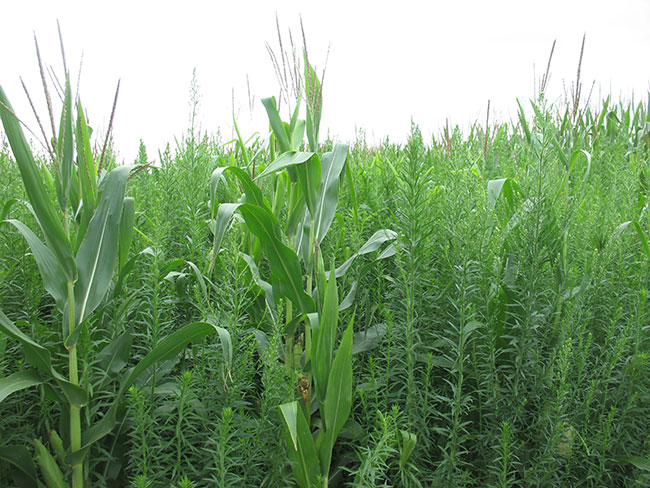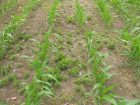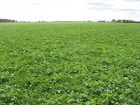
Features
Agronomy
Traits & Stewardship
Weed Management
Finding the right cover crop
Study shows cover crops provide promising control for Canada fleabane in corn.
April 6, 2020 By Julienne Isaacs
 GR Canada fleabane in corn. Photo courtesy of Peter Sikkema.
GR Canada fleabane in corn. Photo courtesy of Peter Sikkema. Cover crops can’t be used as the sole management strategy for weeds in field crops. But as one strategy in an integrated management approach, they show enormous promise, according to University of Guelph professor Peter Sikkema.
“I’ve been working in weed science for 25 years. My research program has been largely focused on herbicides,” Sikkema says.
Two years ago, Sikkema’s graduate student Taiga Cholette published a study looking at suppression of glyphosate-resistant (GR) Canada fleabane in corn with fall-seeded cover crops after winter wheat combining. Of the 15 graduate students Sikkema has supervised who have worked on glyphosate-resistant weeds, Cholette was the first to look specifically at cover crops as a weed management tool.
Cholette’s results were impressive: all of the cover crop treatments tested suppressed GR Canada fleabane in corn the following year compared to the no-cover crop control. Annual ryegrass was most effective: in combination with oilseed radish, it suppressed GR Canada fleabane 87 per cent in the following year’s corn crop.
“Farmers need greater than 95 per cent plus control, so this is not a standalone strategy, but Taiga’s data suggests that cover crops are one component of an overall weed management strategy,” Sikkema says.
“The fact that we’ve relied on herbicides to the exclusion of other weed management tactics has led to widespread herbicide resistance. I’m not throwing darts at anybody because that was considered the best science for 50 years, and I’d have to throw them at myself as well. But I think for long-term sustainable crop and weed management, we need to get more diversity into our weed management programs.”
Study design and results
The experiment was conducted in southwestern Ontario over three years, from 2015 to 2017, and included seven site-years. Studies started when cover crops were seeded after winter wheat harvest in late summer, and completed after corn harvest the following year.
Treatments included oilseed radish, crimson clover, annual ryegrass, oat and cereal rye, seeded alone and in combination. The researchers also looked at three commercial blends: oilseed radish, crimson clover and oat (Cover 60/20/20), pea and triticale (Tripper Maxx), and oat and pea (Sprint Maxx). Every replicate included a no-cover crop control as well as a weed-free control maintained with Marksman applied preplant to corn.
GR Canada fleabane suppression in corn was assessed visually in mid-May and early June, July, August and September, with researchers also evaluating Canada fleabane density and biomass at the beginning of July.
Among the treatments tested, annual ryegrass, crimson clover/annual ryegrass, oilseed radish/crimson clover/annual ryegrass, and oilseed radish/crimson clover/cereal rye were the most consistent treatments for the suppression of GR Canada fleabane in corn.
Annual ryegrass planted alone or in combination with crimson clover provided the most consistent GR Canada fleabane suppression. Planted alone, annual ryegrass suppressed 65 per cent of GR Canada fleabane in May; planted with crimson clover, annual ryegrass suppressed 74 per cent of GR Canada fleabane in the same month.
Ontario farmers typically plant a cover crop blend, Sikkema says. In their current work his research group is looking at oilseed radish and oat blends.
The most logical place for cover crops in Ontario, he says, is after winter wheat combining in a corn-soy-wheat rotation; the benefit is reduced GR Canada fleabane in the subsequent corn crop.
Ongoing research
Ted Vanhie, a master’s student working with University of Guelph professors François Tardif and Clarence Swanton, began a project in May 2018 that also aims to assess the effectiveness of cover crops for Canada fleabane suppression.
Vanhie’s project has four objectives: to validate the suppressive effect of cereal rye against Canada fleabane, to compare rye’s performance to that of other cereals, to evaluate control of Canada fleabane when rye is used in combination with chemical and cultural weed control methods, and to look into the mechanisms responsible for rye’s control of the weed.
One experiment was a field trial that ran on a farm near Delhi, Ont. in 2018 and 2019.
This experiment was organized in a split-strip plot design and looked at control of Canada fleabane with a rye cover crop used in combination with herbicides and/or tillage. For herbicide treatments, Vanhie applied dicamba, saflufenacil and 2,4-D in the spring. Three tillage intensities – no-till, aggressive tillage and passive tillage (a method that disturbs fewer soil aggregates than aggressive tillage) – were compared.
Each possible rye, tillage and herbicide combination was replicated at least three times, notes Vanhie. Population and height measurements were evaluated at zero and four weeks after herbicide application, with visual ratings collected at two and four weeks and Canada fleabane biomass measurements collected at four weeks after application.
Vanhie says the study’s results are still being evaluated, but he’s comfortable saying that rye did suppress Canada fleabane.
“We’re seeing that suppressive interaction. I’m not saying it’s strong enough alone to be your sole weed control method – you’ll need multiple modes of action to control Canada fleabane,” he says.
Vanhie did observe better control of the weed when rye was used in combination with tillage in 2018, although the effect was less consistent in the second year of the study.
Control improved with the addition of an herbicide, particularly dicamba; Vanhie noted that 2,4-D did not provide adequate control to justify the cost of application.
Where rye “really shined,” Vanhie says, was in reducing the density of Canada fleabane. In 2018, the use of rye alone decreased the density of Canada fleabane by roughly half. Rye also reduced the height of Canada fleabane plants that escaped herbicide application or tillage, he says.
While it’s too soon to make specific recommendations, Vanhie says the use of a rye cover crop is very promising – and not just for its efficacy against weeds.
“Oftentimes we come up with strategies to manage weeds but we can overlook costs,” he says. “As part of an integrated management strategy, this is a cost-effective system.”

